Innovative HRM Policy Brief: Work-Family Balance for TelPlus Employees
VerifiedAdded on 2023/04/23
|5
|1078
|321
Report
AI Summary
This report presents a policy brief developed for TelPlus, a major Canadian telecommunications company, addressing significant work-family issues impacting its workforce. The brief, prepared by an HRM student, analyzes the challenges faced by Canadian employees, including long working hours, work-life conflicts, and insufficient salaries, leading to increased stress and reduced productivity. The report explores policy options such as flexible work timings, positive work environments, and reward schemes to improve employee satisfaction and retention. Additionally, it recommends hiring more Asian workers to address labor demands. The report concludes with detailed recommendations for policy implementation, emphasizing employee well-being and organizational efficiency.
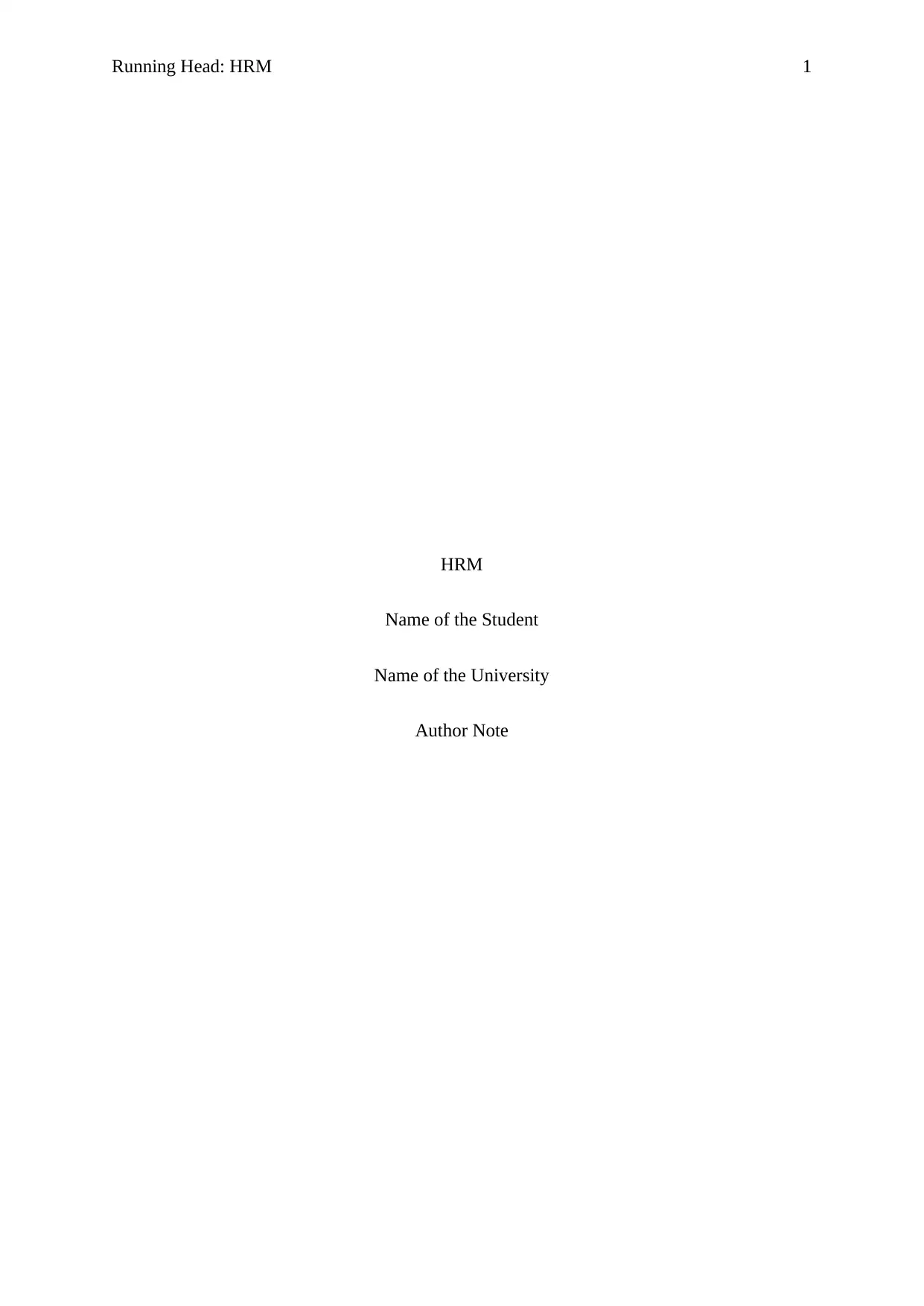
Running Head: HRM 1
HRM
Name of the Student
Name of the University
Author Note
HRM
Name of the Student
Name of the University
Author Note
Paraphrase This Document
Need a fresh take? Get an instant paraphrase of this document with our AI Paraphraser
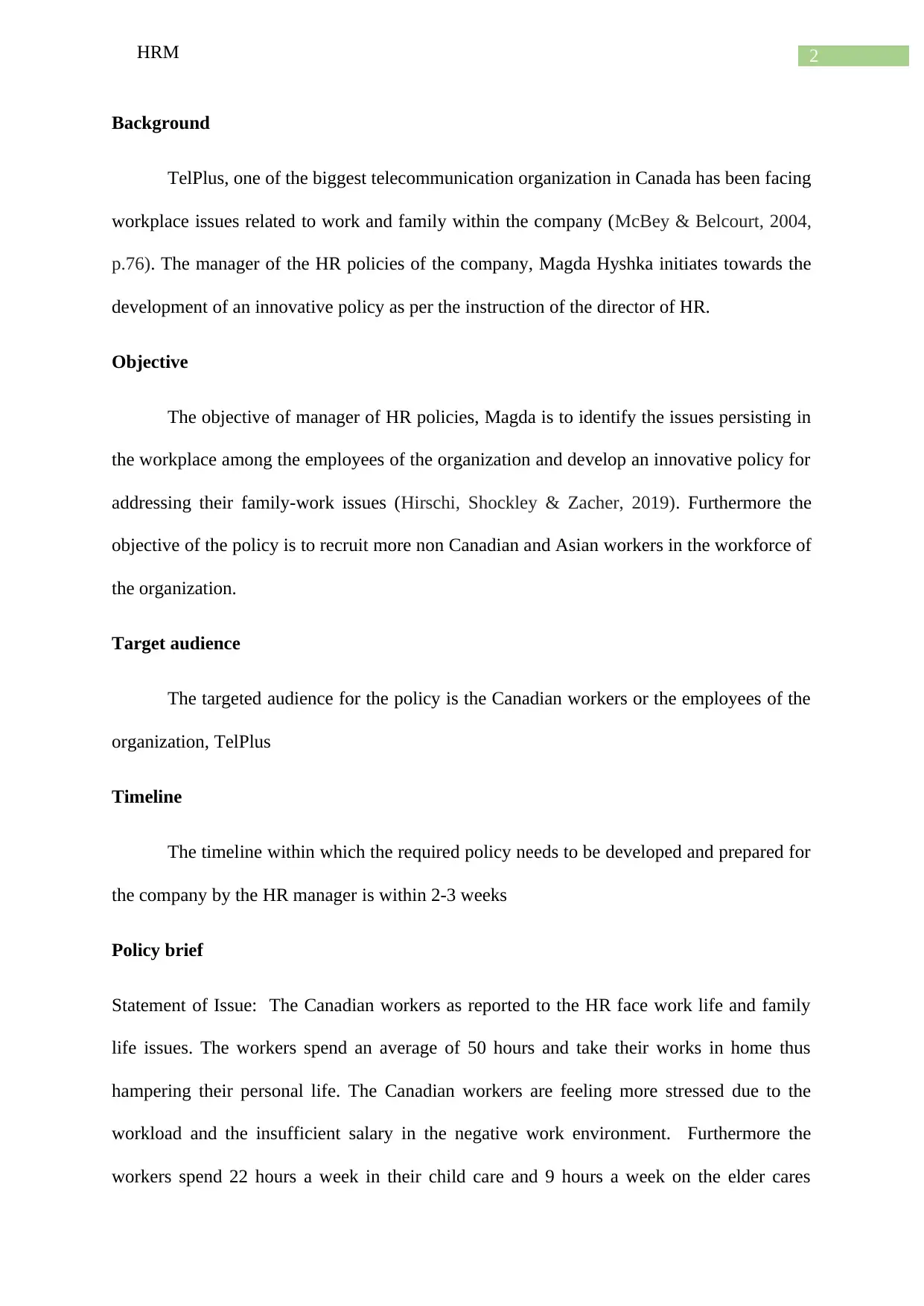
2HRM
Background
TelPlus, one of the biggest telecommunication organization in Canada has been facing
workplace issues related to work and family within the company (McBey & Belcourt, 2004,
p.76). The manager of the HR policies of the company, Magda Hyshka initiates towards the
development of an innovative policy as per the instruction of the director of HR.
Objective
The objective of manager of HR policies, Magda is to identify the issues persisting in
the workplace among the employees of the organization and develop an innovative policy for
addressing their family-work issues (Hirschi, Shockley & Zacher, 2019). Furthermore the
objective of the policy is to recruit more non Canadian and Asian workers in the workforce of
the organization.
Target audience
The targeted audience for the policy is the Canadian workers or the employees of the
organization, TelPlus
Timeline
The timeline within which the required policy needs to be developed and prepared for
the company by the HR manager is within 2-3 weeks
Policy brief
Statement of Issue: The Canadian workers as reported to the HR face work life and family
life issues. The workers spend an average of 50 hours and take their works in home thus
hampering their personal life. The Canadian workers are feeling more stressed due to the
workload and the insufficient salary in the negative work environment. Furthermore the
workers spend 22 hours a week in their child care and 9 hours a week on the elder cares
Background
TelPlus, one of the biggest telecommunication organization in Canada has been facing
workplace issues related to work and family within the company (McBey & Belcourt, 2004,
p.76). The manager of the HR policies of the company, Magda Hyshka initiates towards the
development of an innovative policy as per the instruction of the director of HR.
Objective
The objective of manager of HR policies, Magda is to identify the issues persisting in
the workplace among the employees of the organization and develop an innovative policy for
addressing their family-work issues (Hirschi, Shockley & Zacher, 2019). Furthermore the
objective of the policy is to recruit more non Canadian and Asian workers in the workforce of
the organization.
Target audience
The targeted audience for the policy is the Canadian workers or the employees of the
organization, TelPlus
Timeline
The timeline within which the required policy needs to be developed and prepared for
the company by the HR manager is within 2-3 weeks
Policy brief
Statement of Issue: The Canadian workers as reported to the HR face work life and family
life issues. The workers spend an average of 50 hours and take their works in home thus
hampering their personal life. The Canadian workers are feeling more stressed due to the
workload and the insufficient salary in the negative work environment. Furthermore the
workers spend 22 hours a week in their child care and 9 hours a week on the elder cares
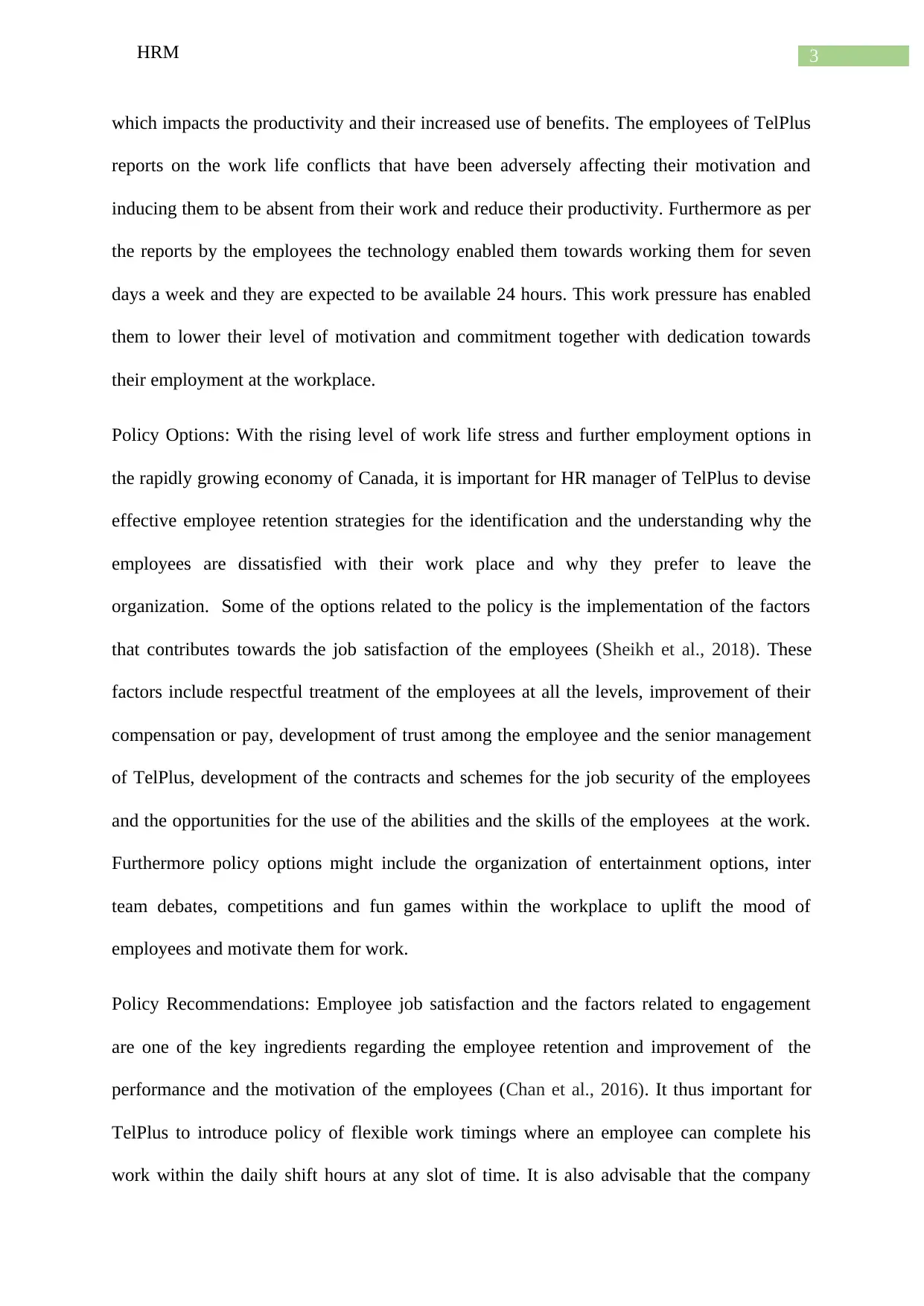
3HRM
which impacts the productivity and their increased use of benefits. The employees of TelPlus
reports on the work life conflicts that have been adversely affecting their motivation and
inducing them to be absent from their work and reduce their productivity. Furthermore as per
the reports by the employees the technology enabled them towards working them for seven
days a week and they are expected to be available 24 hours. This work pressure has enabled
them to lower their level of motivation and commitment together with dedication towards
their employment at the workplace.
Policy Options: With the rising level of work life stress and further employment options in
the rapidly growing economy of Canada, it is important for HR manager of TelPlus to devise
effective employee retention strategies for the identification and the understanding why the
employees are dissatisfied with their work place and why they prefer to leave the
organization. Some of the options related to the policy is the implementation of the factors
that contributes towards the job satisfaction of the employees (Sheikh et al., 2018). These
factors include respectful treatment of the employees at all the levels, improvement of their
compensation or pay, development of trust among the employee and the senior management
of TelPlus, development of the contracts and schemes for the job security of the employees
and the opportunities for the use of the abilities and the skills of the employees at the work.
Furthermore policy options might include the organization of entertainment options, inter
team debates, competitions and fun games within the workplace to uplift the mood of
employees and motivate them for work.
Policy Recommendations: Employee job satisfaction and the factors related to engagement
are one of the key ingredients regarding the employee retention and improvement of the
performance and the motivation of the employees (Chan et al., 2016). It thus important for
TelPlus to introduce policy of flexible work timings where an employee can complete his
work within the daily shift hours at any slot of time. It is also advisable that the company
which impacts the productivity and their increased use of benefits. The employees of TelPlus
reports on the work life conflicts that have been adversely affecting their motivation and
inducing them to be absent from their work and reduce their productivity. Furthermore as per
the reports by the employees the technology enabled them towards working them for seven
days a week and they are expected to be available 24 hours. This work pressure has enabled
them to lower their level of motivation and commitment together with dedication towards
their employment at the workplace.
Policy Options: With the rising level of work life stress and further employment options in
the rapidly growing economy of Canada, it is important for HR manager of TelPlus to devise
effective employee retention strategies for the identification and the understanding why the
employees are dissatisfied with their work place and why they prefer to leave the
organization. Some of the options related to the policy is the implementation of the factors
that contributes towards the job satisfaction of the employees (Sheikh et al., 2018). These
factors include respectful treatment of the employees at all the levels, improvement of their
compensation or pay, development of trust among the employee and the senior management
of TelPlus, development of the contracts and schemes for the job security of the employees
and the opportunities for the use of the abilities and the skills of the employees at the work.
Furthermore policy options might include the organization of entertainment options, inter
team debates, competitions and fun games within the workplace to uplift the mood of
employees and motivate them for work.
Policy Recommendations: Employee job satisfaction and the factors related to engagement
are one of the key ingredients regarding the employee retention and improvement of the
performance and the motivation of the employees (Chan et al., 2016). It thus important for
TelPlus to introduce policy of flexible work timings where an employee can complete his
work within the daily shift hours at any slot of time. It is also advisable that the company
⊘ This is a preview!⊘
Do you want full access?
Subscribe today to unlock all pages.

Trusted by 1+ million students worldwide
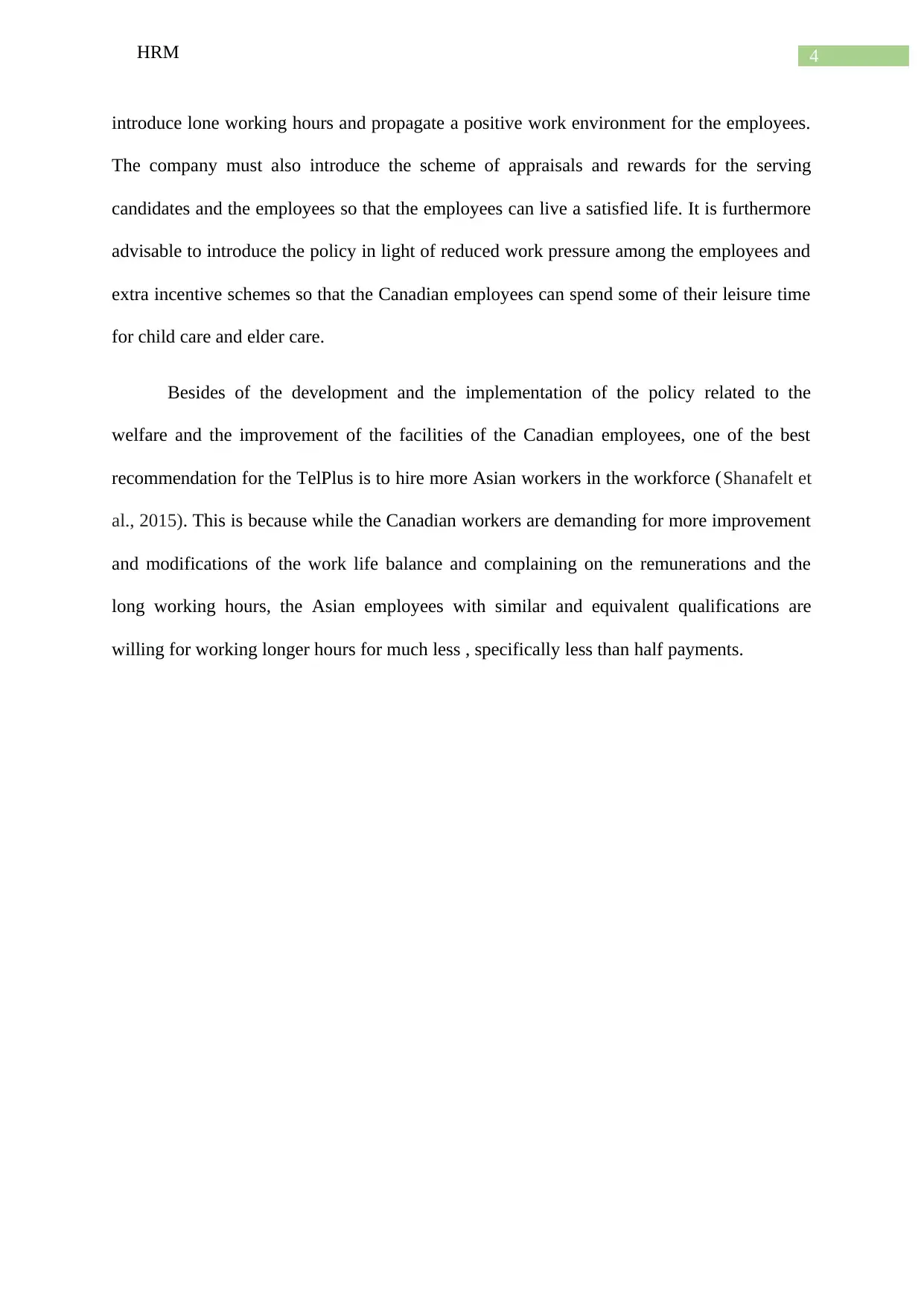
4HRM
introduce lone working hours and propagate a positive work environment for the employees.
The company must also introduce the scheme of appraisals and rewards for the serving
candidates and the employees so that the employees can live a satisfied life. It is furthermore
advisable to introduce the policy in light of reduced work pressure among the employees and
extra incentive schemes so that the Canadian employees can spend some of their leisure time
for child care and elder care.
Besides of the development and the implementation of the policy related to the
welfare and the improvement of the facilities of the Canadian employees, one of the best
recommendation for the TelPlus is to hire more Asian workers in the workforce (Shanafelt et
al., 2015). This is because while the Canadian workers are demanding for more improvement
and modifications of the work life balance and complaining on the remunerations and the
long working hours, the Asian employees with similar and equivalent qualifications are
willing for working longer hours for much less , specifically less than half payments.
introduce lone working hours and propagate a positive work environment for the employees.
The company must also introduce the scheme of appraisals and rewards for the serving
candidates and the employees so that the employees can live a satisfied life. It is furthermore
advisable to introduce the policy in light of reduced work pressure among the employees and
extra incentive schemes so that the Canadian employees can spend some of their leisure time
for child care and elder care.
Besides of the development and the implementation of the policy related to the
welfare and the improvement of the facilities of the Canadian employees, one of the best
recommendation for the TelPlus is to hire more Asian workers in the workforce (Shanafelt et
al., 2015). This is because while the Canadian workers are demanding for more improvement
and modifications of the work life balance and complaining on the remunerations and the
long working hours, the Asian employees with similar and equivalent qualifications are
willing for working longer hours for much less , specifically less than half payments.
Paraphrase This Document
Need a fresh take? Get an instant paraphrase of this document with our AI Paraphraser
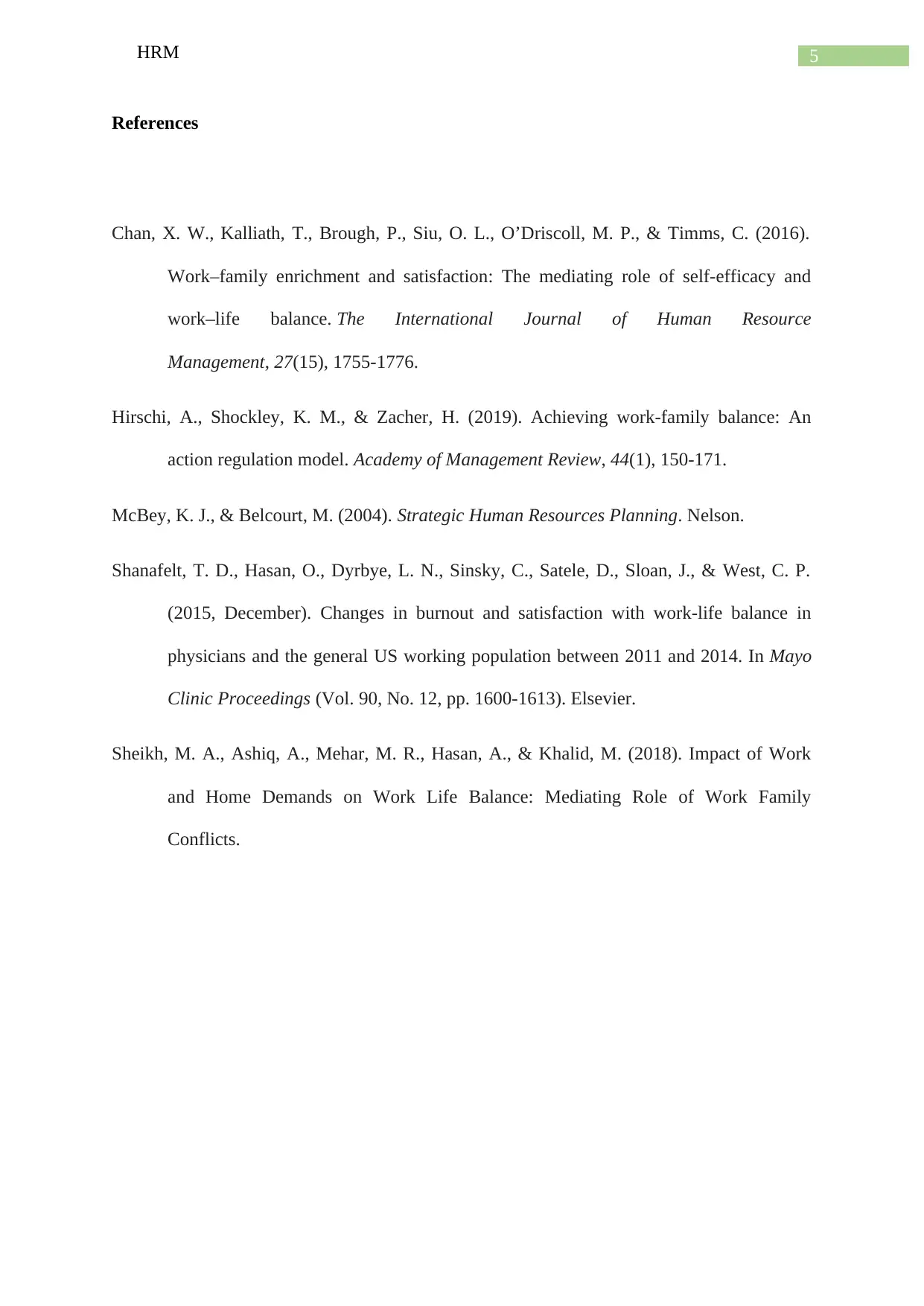
5HRM
References
Chan, X. W., Kalliath, T., Brough, P., Siu, O. L., O’Driscoll, M. P., & Timms, C. (2016).
Work–family enrichment and satisfaction: The mediating role of self-efficacy and
work–life balance. The International Journal of Human Resource
Management, 27(15), 1755-1776.
Hirschi, A., Shockley, K. M., & Zacher, H. (2019). Achieving work-family balance: An
action regulation model. Academy of Management Review, 44(1), 150-171.
McBey, K. J., & Belcourt, M. (2004). Strategic Human Resources Planning. Nelson.
Shanafelt, T. D., Hasan, O., Dyrbye, L. N., Sinsky, C., Satele, D., Sloan, J., & West, C. P.
(2015, December). Changes in burnout and satisfaction with work-life balance in
physicians and the general US working population between 2011 and 2014. In Mayo
Clinic Proceedings (Vol. 90, No. 12, pp. 1600-1613). Elsevier.
Sheikh, M. A., Ashiq, A., Mehar, M. R., Hasan, A., & Khalid, M. (2018). Impact of Work
and Home Demands on Work Life Balance: Mediating Role of Work Family
Conflicts.
References
Chan, X. W., Kalliath, T., Brough, P., Siu, O. L., O’Driscoll, M. P., & Timms, C. (2016).
Work–family enrichment and satisfaction: The mediating role of self-efficacy and
work–life balance. The International Journal of Human Resource
Management, 27(15), 1755-1776.
Hirschi, A., Shockley, K. M., & Zacher, H. (2019). Achieving work-family balance: An
action regulation model. Academy of Management Review, 44(1), 150-171.
McBey, K. J., & Belcourt, M. (2004). Strategic Human Resources Planning. Nelson.
Shanafelt, T. D., Hasan, O., Dyrbye, L. N., Sinsky, C., Satele, D., Sloan, J., & West, C. P.
(2015, December). Changes in burnout and satisfaction with work-life balance in
physicians and the general US working population between 2011 and 2014. In Mayo
Clinic Proceedings (Vol. 90, No. 12, pp. 1600-1613). Elsevier.
Sheikh, M. A., Ashiq, A., Mehar, M. R., Hasan, A., & Khalid, M. (2018). Impact of Work
and Home Demands on Work Life Balance: Mediating Role of Work Family
Conflicts.
1 out of 5
Related Documents
Your All-in-One AI-Powered Toolkit for Academic Success.
+13062052269
info@desklib.com
Available 24*7 on WhatsApp / Email
![[object Object]](/_next/static/media/star-bottom.7253800d.svg)
Unlock your academic potential
Copyright © 2020–2025 A2Z Services. All Rights Reserved. Developed and managed by ZUCOL.




